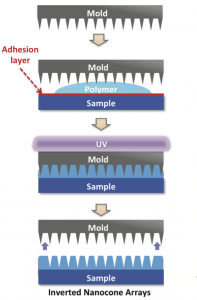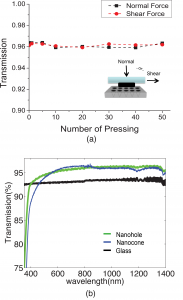Inverted Nanocone Arrays with High Aspect Ratio for Mass-producible Multifunctional Films
- Category: Nanotechnology
- Tags: george barbastathis, jeong-gil kim
Inspired by natural structures in insect compound eyes, nanocone structures form an effective medium with an axial gradient in the refractive index, which leads to elimination of impedance mismatch at optical interfaces and hence suppresses Fresnel reflection[1]. In the past we have shown that the functionality of these surfaces can be optimized by increasing the aspect ratio, since taller, narrow nanostructures contribute to a lower reflection coefficient[2]. However, it is inevitable that the high aspect ratio of the slender cones is also detrimental to the mechanical robustness of the nanostructured surface, which is a critical barrier when developing textured substrates for real world applications. Here, we propose and then fabricate an inverted nanocone structure to create an improved biomimetic multifunctional film with greater mechanical robustness. While retaining the high aspect ratio of tapered nanostructures for enhancing the optical and wetting performance, the inverted nanocone structure also provides high mechanical robustness regardless of its aspect ratio.
The inverted nanocone surface is fabricated using a simple UV replication method[3],[4] with high throughput as shown in Figure 1. A negative master mold comprising a wide area periodic array of nanoconical features was prepared using laser interference lithography ((K.-C. Park, H. J. Choi, C.-H. Chang, R. E. Cohen, G. H. McKinley, and G. Barbastathis, “Nanotextured Silica Surfaces with Robust Super-Hydrophobicity and Omnidirectional Broadband Super-Transmissivity,” ACS Nano, vol. 6 (5), pp. 3789–3799, Apr. 2012.)) in a fused silica substrate. Then it was replicated into UV curable polymer by a sequence of pressing, UV curing, and demolding steps. The fabricated inverted nanocone arrays have a pitch of 200 nm and aspect ratio of 4:1. The mechanical strength of the proposed inverted nanocone structure was quantitatively measured by applying repeated shear and normal force to the surface as shown in Figure 2 (a). Also measurements of the transmission spectra for the inverted nanocone texture were carried out in the visible to near infrared range as shown in Figure 2 (b).
- Figure 1: Fabrication process of the inverted nanocone arrays replicated from nancone arrays.
- Figure 2: (a) Mechanical robustness test of surfaces textured with inverted nanocone arrays. Optical transmission of the nanotextured surface after applying normal and shear force through a rubber pad. (b) Optical transmission of broadband measurement using normal incident light.
- Y. Kanamori, M. Sasaki, and K. Hane, “Broadband Antireflection Gratings Fabricated Upon Silicon Substrates,” Opt. Lett. 24, pp.1422-1424, Oct. 1999. [↩]
- K.-C. Park, H. J. Choi, C.-H. Chang, R. E. Cohen, G. H. McKinley, and G. Barbastathis, “Nanotextured Silica Surfaces with Robust Super-Hydrophobicity and Omnidirectional Broadband Super-Transmissivity,” ACS Nano, vol. 6 (5), pp. 3789–3799, Apr. 2012. [↩]
- S. Y. Chou, P. R. Krauss, and P. J. Renstrom, “Nanoimprint Lithography,” J. Vac. Sci. Technol. B 14, pp. 4129-4133, June 1996. [↩]
- Jeong-Gil Kim, Youngsuk Sim, Youngtae Cho, Jung-Woo Seo, Sin Kwon, Jung-Woo Park, Hyoung Gil Choi, Hyuk Kim and Sukwon Lee, “Large area pattern replication by nanoimprint lithography for LCD–TFT application,” Microelectronic Engineering, vol. 86, pp. 2427–2431, Dec. 2009. [↩]

